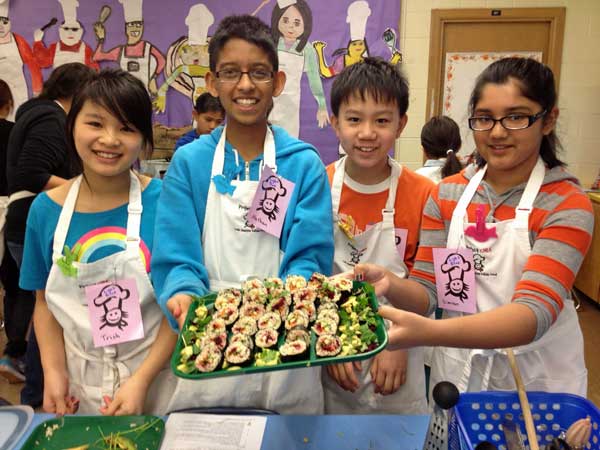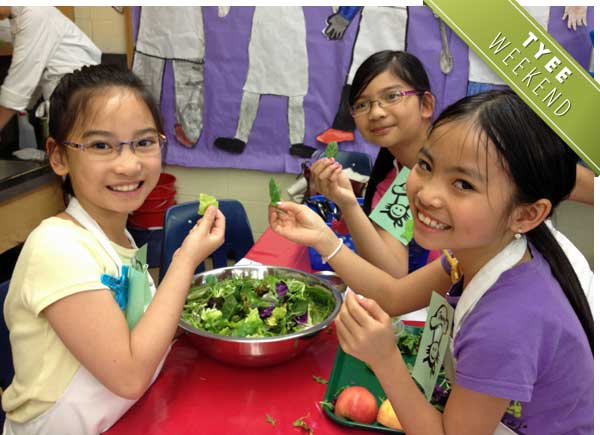Imagine elementary school kids preparing meals of golden-crusted macaroni and cheese casseroles made with homemade béchamel and whole wheat rotini; fragrant pots of minestrone soup with fresh herbs and over half a dozen different local vegetables; a vibrantly coloured stirfry with tofu in a savoury sauce; or steaming bowls of creamy breakfast porridge loaded with oats, millet, amaranth and quinoa, flavoured with cinnamon, honey and dried fruits, and topped with chunky homemade applesauce.
The Project Chef program, developed and run by Barbara Finley, is teaching students from Kindergarten to Grade 7 in public schools across Vancouver how to make these and other delicious and healthy dishes for themselves and their families. Finley has developed a fun and mobile curriculum that covers food and kitchen safety, the origin and nature of food, good nutrition, culinary techniques, the significance of local farms and producers, as well as the pleasures of sharing homemade food and good conversation at a sit-down meal with people you care about.
One morning earlier this year, I visited an enthusiastic class of Grade 4 students at Sir Wilfred Grenfell Elementary School on the city's east side to see Project Chef in action. It was clear the program was in full swing, given the wonderful food-themed student artwork and writing decorating the hallways. As the kids filed into the classroom, they knew to wash their hands thoroughly at the classroom sink, tie back their hair, put on their aprons, and go to one of the seven stations they'd been assigned to. Each station was provided with a bin of cooking implements brought in by Project Chef. (Stations can also be provided with individual cook-tops and electric frying pans depending on what dish is being prepared that day.)
After attendance, the students gathered around Chef Barb at the front of the class for a talk about grains. As she passed around a stalk of wheat, some of the kids craned their necks at the prospect of seeing and touching one for the first time. On the blackboard was a poster showing various kinds of grains, as well as a drawing of a cross-section of a whole grain indicating its constituent parts of endosperm, bran and germ. Chef Barb discussed how whole grains contain more nutrition, showing the students a small container of both white and whole wheat flour so they could see the difference for themselves. Earlier in the week, the class learned about how different fruits and vegetables represent different parts of a plant, for example how tomatoes and zucchini are actually fruits because of their seeds.
'Open mind, open mouth'
This morning's class was going to make Speedy Whole Wheat Pizza. Each student was given a handout with a recipe, the instructions broken down into simple, explicit steps that adults might take for granted: not just "mix together liquid ingredients," but "Measure the milk. Pour into a medium-sized bowl. Add the olive oil. Stir together with a spoon or whisk." The instructions were also provided in picture-form.
After completing the first step of making the pizza dough, the kids gathered around Chef Barb again to see a demonstration of the next step: how to knead the dough and roll it out properly, and how to put on the sauce, slice the vegetables and grate the cheese. I was amazed to see the children folding and turning the dough like seasoned pros. Everyone knew how to slice their mushrooms and zucchini sections properly using the "claw and saw" technique that Chef Barb taught them earlier in the week: curling the fingertips of one hand like a claw to hold down the vegetable on its flat side against the chopping surface, while using a sawing motion with a knife in the other hand. Each station was supervised by one of Project Chef's two assistants or a parent volunteer, as well as overseen by the chef-teacher and main classroom teacher.
Every child in each group had a rotating task, such as obtaining the ingredients, washing, rinsing or drying dishes, or obtaining and returning larger equipment such as the baking sheets or washing basins to a Project Chef assistant. At my table, two of the kids jockeyed for position to wash the dishes: clearly the sudsy warm water was an attraction. As the enticing scent of baking pizza wafted down from the staff room to the classroom, the kids set the table. When the much anticipated pizzas arrived at each station, Chef Barb reminded the students to conduct a pleasant meal-time conversation while eating.
One child was clearly vegetable-phobic, but after being reminded of Project Chef's oft-repeated motto, "Open mind, open mouth," he gamely took a bite. I held back a chuckle when he actually shuddered as his tongue touched the zucchini -- he removed the offending item before he could resume eating. Other kids in the group had no problem devouring their portions or claiming a second piece. After eating and clearing the tables, the students had time to reflect on their experiences of food. They were asked to depict a special dinner that their families usually enjoy, to jot down one of the kitchen safety rules they had learned, and then to draw or write about a favourite item they had made or eaten that week.
The enthusiasm of the students was contagious. They were learning team work and organization, learning hands-on practical skills that would help them outside of school, understanding the flaws of processed foods, and gaining useful information that would help them to buy and eat healthy foods, now and later in life.
7,000 budding chefs and counting
Finley and her two Project Chef assistants start at a new school at the beginning of the week, teaching a morning and an afternoon class of approximately 30 students each for four or five consecutive days. The two-and-a-half-hour time blocks are necessary to give enough time for a lesson and demonstration, hands-on preparation by the kids, eating and clean up. The program can be run right in the classroom as long as there is a sink and access to a refrigerator in the school. At the end of the week, the program is ready to move on to another school.
Depending on funding, the program can occasionally organize field trips to farms, grocery stores, and public markets, or go behind the scenes to a local restaurant's kitchen. The program has included visits from Top Chef Canada contestant, Chef Matt Stowe who wrote about how he was "blown away by the program," as well as notable chef Rob Clark and Olympic athlete, Georgia Simmerling.

This past school year, the program worked with 1,500 children from 55 classes across 28 weeks. Over the six years the program has operated, it has taught 6,990 children from 245 classes in 88 schools, engaging over 3,700 parent and community volunteers. One hundred per cent of school staff evaluations rated the program as excellent.
This spring, Project Chef received the B.C. School Superintendents Association Award of Recognition for contributions to public education. Finley was invited to participate in the Ministry of Health Provincial Food Skills Think Tank. She is also currently on the Public Health Association of B.C. Farm to School Task Force, as well as on the B.C. Ministry of Health/YMCA Advisory Committee to develop a resource kit for healthy eating in after-school settings.
Fruits of a lifelong passion
The program represents a confluence of Finley's skills, experience and passion. She was a teacher for over 25 years, working in Langley before completing her Master's in Education at the University of British Columbia and teaching there for 10 years, the last two of which she also taught part-time through the Vancouver School Board.
Finley inherited her passion for food and cooking from her mother. "My mom was an amazing cook. Our year was built around food, whether it was picking berries, canning salmon or peaches, making Christmas cake," she said during a telephone interview. She decided to enroll at Dubrulle culinary school, where she also developed a kids cooking program. She then taught in the professional culinary and pastry programs at Northwest Culinary Academy of Vancouver while teaching various kids cooking programs around town. She later developed cooking programs for independent schools, including York House junior school.
It was at the conclusion of a 10-week-long Lifeskills program at Point Grey High School, when she saw the immense pride with which teenagers prepared and served a meal for family, peers and teachers, that she decided to develop a streamlined and affordable program for public schools. The first pilot project in 2007 was highly successful and has continued to expand since.
Finley has been intensely gratified by her experiences so far. Children who normally don't like to write have been inspired to write pages about their Project Chef experience, writing essays, blogs and poems, and making cookbooks. Some have made beautiful paintings and drawings or put together iPod video presentations. Some classes have explored other cultures through food: a Grade 6 class at Grenfell made Afghan boulani, and Grade 6 and 7 students studying ancient Rome at Bayview Elementary School dressed in togas or as gladiators and prepared food based on fourth century Roman recipes, including omelets with honey and cinnamon, "must" bread, spiced grape juice, poached pears and roasted spiced squash. Other children have cooked for and with their families for the first time.
Finley told me of her desire to make an impact, especially among kids of the working poor. "They are the most vulnerable. Both parents are working and aren't home a lot. There aren't the school programs after school. It's the grey zone where there isn't the funding and there isn't the support systems -- these are the kids that are often most in need." She talked about statistics indicating that 70 per cent of children don't eat meals regularly with their families around the table, about rising rates of childhood obesity and related learning and health problems.
A moveable feast
This school term, the Project Chef program conducted week-long cooking classes in a number of elementary schools around town selected by lottery, including Sir William Osler, Queen Mary, The Tyee, Sir Wilfred Laurier, University Hill and Charles Dickens. The program will continue at Sir Alexander Mackenzie and Laurier Annex in the new year, followed by two longer-term residencies of six weeks each at Nootka Elementary and Graham Bruce Elementary. Project Chef conducted two professional development days for staff at Nootka and Graham Bruce earlier this fall in preparation for those residencies.
Funding constraints prevent Project Chef from meeting the huge demand for its program. There is a long waiting list of public schools, along with requests from independent schools, schools from other districts and community organizations. Funding for Project Chef comes from a constellation of private donors, both individual and corporate. The program receives no public funding from the Vancouver School Board. A significant part of Finley's time outside the classroom is spent negotiating funding and writing grant proposals. However, she remains hopeful that she can continue to pass on her beloved mother's legacy and her own passion for food and community to hundreds of children every year.
Finley recalls a particular day as a highlight last term. The Project Chef program celebrated the exuberant finale of its residency program at one school in the morning, followed in the afternoon by an enthusiastic school reception at the commencement of the residency program at another school. She wrote in a blog post: "If we could bottle the energy and enthusiasm around food that was created... we could remedy our society's disconnection with the food we eat," she wrote. "It was an overwhelming day that demonstrated the importance of food in our lives: nutritionally, socially, culturally, environmentally and emotionally." ![]()
















Tyee Commenting Guidelines
Comments that violate guidelines risk being deleted, and violations may result in a temporary or permanent user ban. Maintain the spirit of good conversation to stay in the discussion.
*Please note The Tyee is not a forum for spreading misinformation about COVID-19, denying its existence or minimizing its risk to public health.
Do:
Do not: